Concepts of Population Ecology
Understanding the dynamics of the population is at the core of ecology. Through this article, you’ll be able to explore the fundamental concepts of population ecology and learn how this knowledge can be applied to help us use our natural resources without damaging them.
Table of Contents
- Introduction to Population Structure & Dynamics
- Models of Population Growth
- Factors Affecting Population Growth
- Life History Patterns
- Practical Applications of Population Ecology
- Download Article in PDF Format.
- Test Yourself!
Introduction to Population Structure & Dynamics
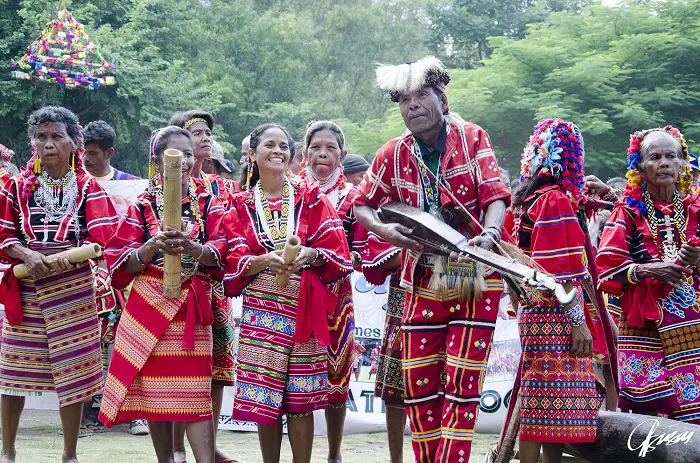
Ecologists define a population as a group of individuals of a single species that occupy the same area. These individuals require the same resources, are influenced by the same environmental factors, and are able to breed and interact with one another.
Population ecology is concerned with changes in population size and the factors that regulate it over time. One important aspect of the population’s dynamics is population growth.
Two important factors are important in shaping a population: density and dispersal. Population density refers to the number of individuals of a species per unit area. Because it is impractical or impossible to count all individuals in a population in most cases, ecologists use various sampling techniques to estimate the population densities. Dispersal or the dispersion pattern of a population refers to the way individuals are spaced within an area.
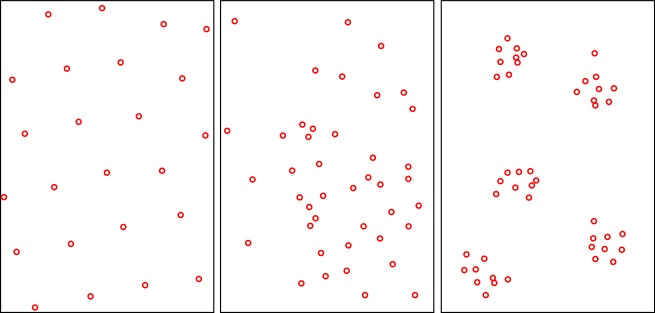
A clumped dispersion pattern occurs when individuals are grouped in patches. It is the most common pattern in nature. This pattern is mainly because the resources required are unevenly distributed in a given area. For instance, you may see plants grow in a certain space on an open lot where you may presume the soil is ideal for their growth. Clumping in animals, meanwhile, is often due to uneven food distribution.
A uniform dispersion pattern often comes from interactions between individuals of the population. Some plants, through allelopathy, inhibit the growth of nearby plants that could compete for the same resources. Animals may become evenly dispersed due to territorial behavior.
In random dispersion, individuals are spaced in an unpredictable manner and so there is no pattern. Plants may become randomly dispersed when their seeds go with the wind. However, varying habitat conditions and social interactions make random dispersion rare.
Estimating density and dispersion enables researchers to monitor changes in a population and compare and contrast them with the growth and stability of populations in different areas. Another tool an ecologist uses to study populations is the life table. Life tables track survivorship, the chance of an individual in a given population surviving at various ages.
Life tables are used to construct survivorship curves, which plot survivorship as the proportion of individuals from an initial population that is alive as they age. The survivorship curves can fall into three curve types:
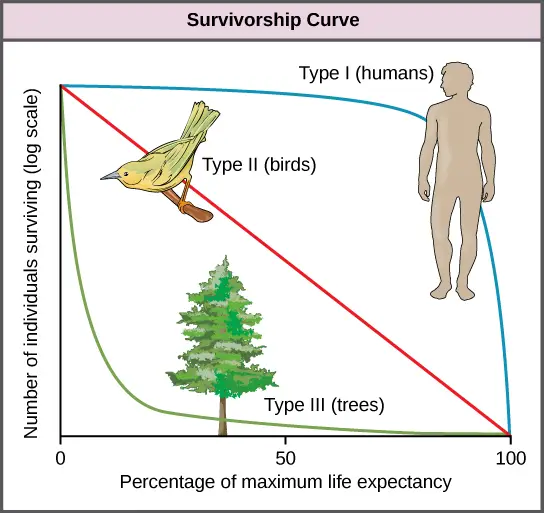
- A Type I survivorship curve shows that most individuals survive to the older age. Humans and other large mammals usually show this curve as even though we produce few offspring, we take good care of them such that they are able to live to maturity.
- A Type II curve is an intermediate, showing that survivorship is constant over the life span. That is, the individuals with this curve are, no more or less, vulnerable at one stage of their life cycle than at another. This has been observed in some lizards and rodents.
- Type III curve is in contrast to the Type I curve. It indicates low survivorship for the young, followed by a period when survivorship is high for those few individuals that can live to a certain age. Species with this curve often produce numerous offspring but provide little to no care for them. For example, some fishes spawn many eggs and sperm into the water but most of the fertilized and resulting larvae die from predation or other causes.
In the next topic, we will delve into the models created by ecologists to understand population growth.
Models of Population Growth
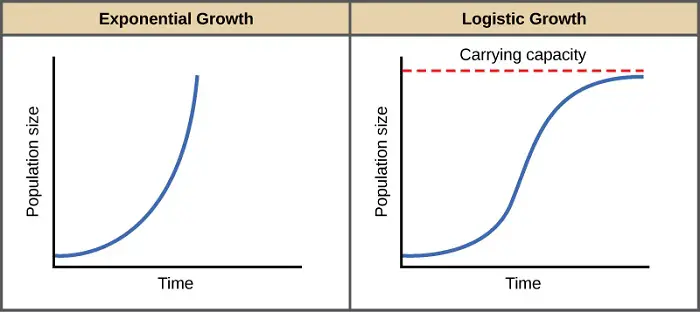
Population size fluctuates as individuals are born or migrate into an area while there are also others that die or move out of the area. Using idealized models, population ecologists are able to predict changes in population size over time under different conditions.
The exponential growth model is one idealized model that gives a picture of unlimited population growth. It has no restrictions on how organisms live, grow, and reproduce. In a population growing in an ideal environment with unlimited space and resources, the population increases with a rate known as maximum capacity. That is, the number of individuals born is subtracted by the number of deaths in a given period.
This model assumes that immigration and emigration into the area are equal hence it does not affect maximum capacity. Graphing this model produces a J-shaped curve, where the lower part of the J shows a slope of the line that is almost flat, suggesting relatively slow growth when the population is small and as the population grows, the slope becomes steeper.
In nature, a population when introduced to a new environment or recovering from a catastrophic decline in numbers may grow exponentially for a while. Eventually, different environmental factors will limit its growth rate as the population reaches its maximum sustainable size. These environmental factors are called limiting factors.
If limiting factors would be introduced into the J-curve of exponential growth, it would result in the flattening of the higher part of the J leading to a more S shape. This S shape is characteristic of the logistic growth model. The upper threshold that flattens the curve is known as carrying capacity, the maximum population size that a particular space can sustain.
Factors Affecting Population Growth
The logistic growth model predicts that population growth will slow and eventually stop as population density increases. That is, at higher population densities, the birth rate decreases while the death rate increases or both rates increase.
One factor affecting growth is density-dependent factors. These are limiting factors that intensify with population density, that is, they restrict growth in natural populations. The most obvious is an intraspecific competition where individuals of the same species compete for the same, limited resources. More individuals may also increase the death rate as competition becomes fiercer or the availability of space decreases, say, for plants.
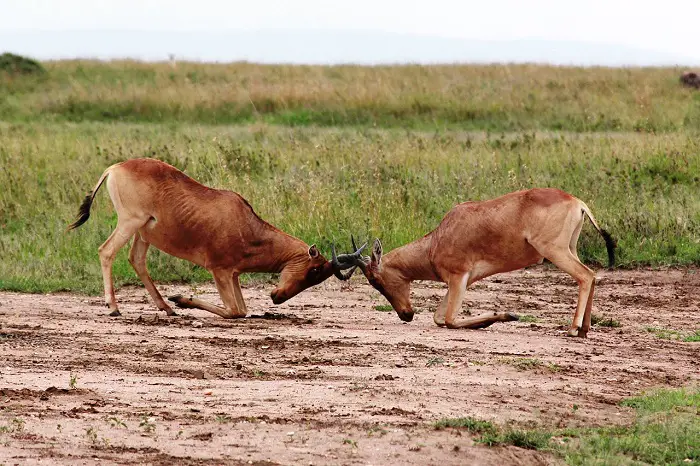
A limiting factor whose intensity is not related to population density is called a density-independent factor. For example, the weather may affect population size long before density-dependent factors become important. This is also why habitat disruption by human activity is a problem as it affects populations regardless of their densities.
In the long term, however, most populations are regulated by a mixture of factors. Some populations may remain stable in size and are presumably close to a carrying capacity, determined by biotic factors.
Most populations with long-term data, however, show fluctuations in numbers and these come from a complex interaction of both density-dependent and density-independent factors. And so, these must be taken into consideration when ecologists are trying to study populations of a specific or several organisms and test their hypotheses.
Life History Patterns
These factors go back in influencing the life history patterns, an organism’s schedule for reproducing and death. Because of different selective pressures and their variety, the life histories of organisms vary.
One life history pattern is shown by small-bodied, short-lived animals (such as insects and small rodents) where they develop and become sexually mature rapidly, have a large number of offspring but offer little or no parental care. Plants that produce thousands of tiny seeds show this pattern also.
Ecologists hypothesize that selection for these organisms occurs in environments where resources are abundant, allowing exponential growth. This selection is called r-selection and r-selected species have an advantage in habitats that experience unpredictable disturbances.
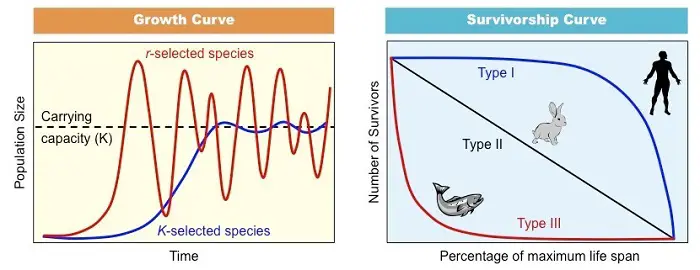
Another type is K-selection which occurs in large-bodied, long-lived animals and for comparable plants such as the coconut, which produce relatively few seeds that are well-stocked with nutrients. The hypothesis for this selection occurs in environments where the population size is near carrying capacity. K-selected organisms are adapted to environments with a relatively stable climate and little opportunity for rapid population growth.
Both r and K are factors used in equations for population growth with r referring to the rate of increase and K standing for carrying capacity. Although the concept of r- and K-selection are criticized as oversimplification, this approach stimulated a vigorous field of research on the evolution of life histories.
Practical Applications of Population Ecology
The different principles of population ecology can help us guide toward resource management goals. Sustainable resource management practices allow the use of a natural resource without damaging it. In terms of our living resources, it means maintaining a high population growth rate to replenish the resource.
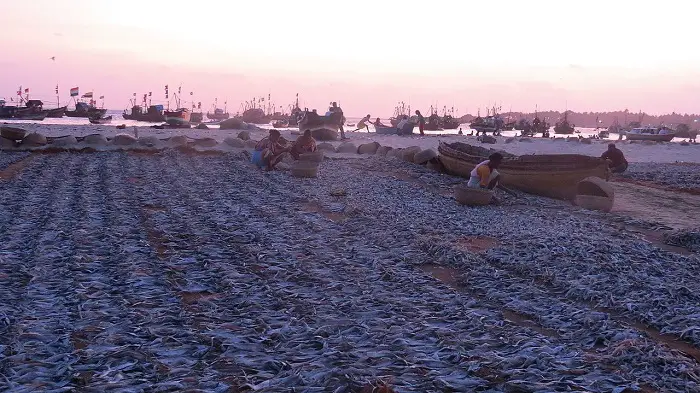
Fish are wild animals still hunted on a large scale and are very vulnerable to overharvesting. If practices remain unsustainable, it would negatively affect our fishing communities and countries which are heavily reliant on fishing for maintaining or bolstering their economy. Killing pests with insecticides may also be not as effective as you may also kill their predators and because of selection, they may just bounce back.
As you’ve learned, there are many factors that influence a population’s size. To effectively manage any population, we must identify those variables, account for the unpredictability of the environment, consider the organism’s interactions with other species, and weigh the economic, political, and conservation issues. These same issues apply to the growth of human populations.
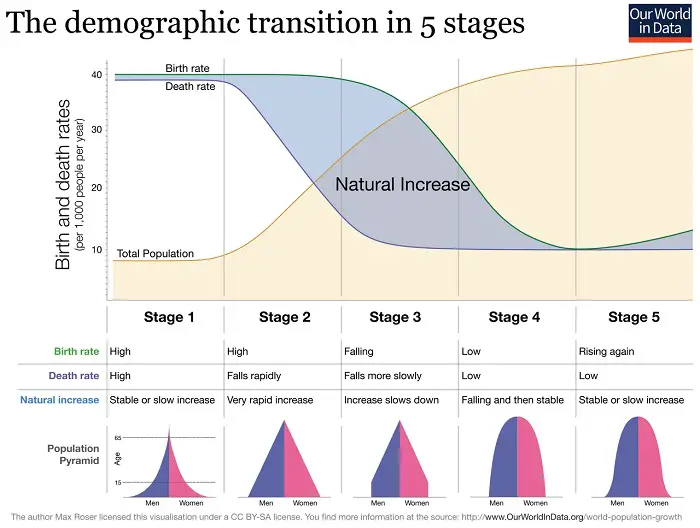
You might have heard of the term demographic transition which is a shift in birth rates and death rates depending on conditions of the population. It states that there are high birth and death rates in populations with less or slower education, technology, or economic development. That shifts to low birth and death rates when the economy, education, and technology advances greatly.
As you see, it affects the life history and can also contribute to the age structure of a population. A population’s age structure can be visualized into a diagram and is helpful for demographers in predicting a population’s future growth. With regards to human resource usage, the more common term thrown around is ecological footprint, an estimate of the land and water area required to provide resources an individual or a nation consumes and to absorb the waste it generates.
Our carbon footprint refers to the carbon dioxide and other greenhouse gas emissions and so, regulating this footprint is important as an unbalanced number of greenhouse gases in the atmosphere affects the climate, which goes full circle to what we have introduced in the early parts of this section of the reviewer.
In the succeeding topics, we will go a step up in the hierarchy to understand the dynamics of communities.
Next topic: Community Structure and Dynamics
Previous topic: Biomes of Planet Earth
Return to the main article: The Principles of Ecology
Download Article in PDF Format.
Test Yourself!
1. Practice Questions [PDF Download]
2. Answer Key [PDF Download]
Copyright Notice
All materials contained on this site are protected by the Republic of the Philippines copyright law and may not be reproduced, distributed, transmitted, displayed, published, or broadcast without the prior written permission of filipiknow.net or in the case of third party materials, the owner of that content. You may not alter or remove any trademark, copyright, or other notice from copies of the content. Be warned that we have already reported and helped terminate several websites and YouTube channels for blatantly stealing our content. If you wish to use filipiknow.net content for commercial purposes, such as for content syndication, etc., please contact us at legal(at)filipiknow(dot)net